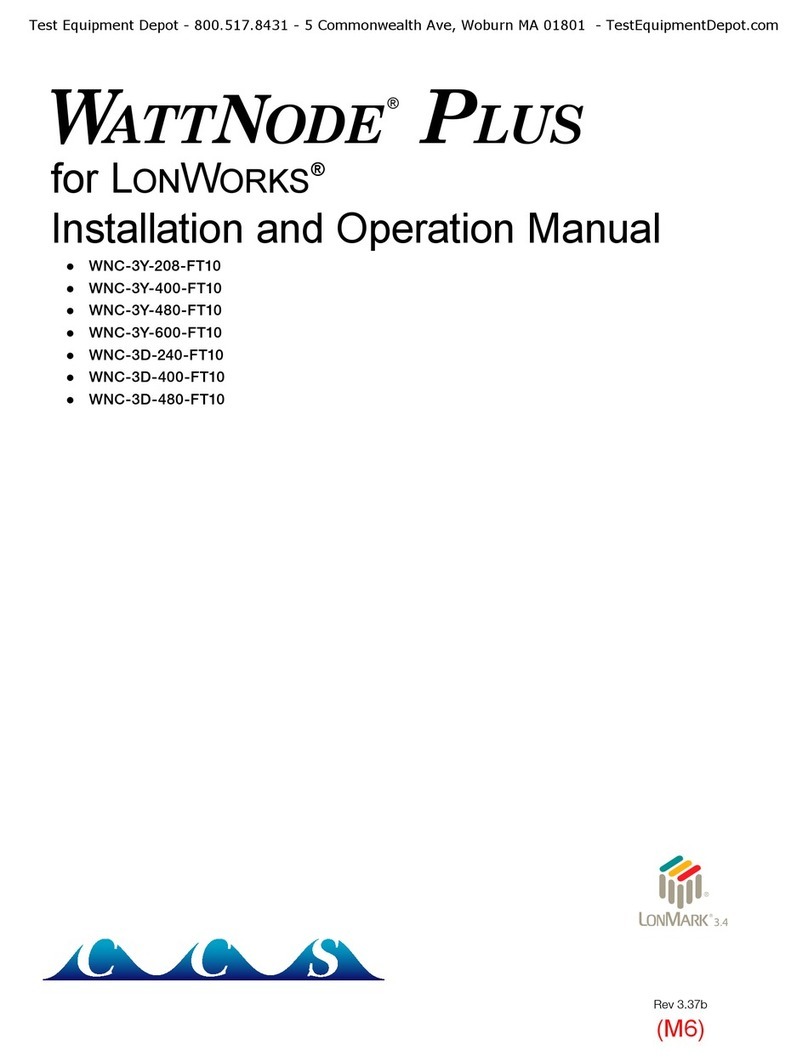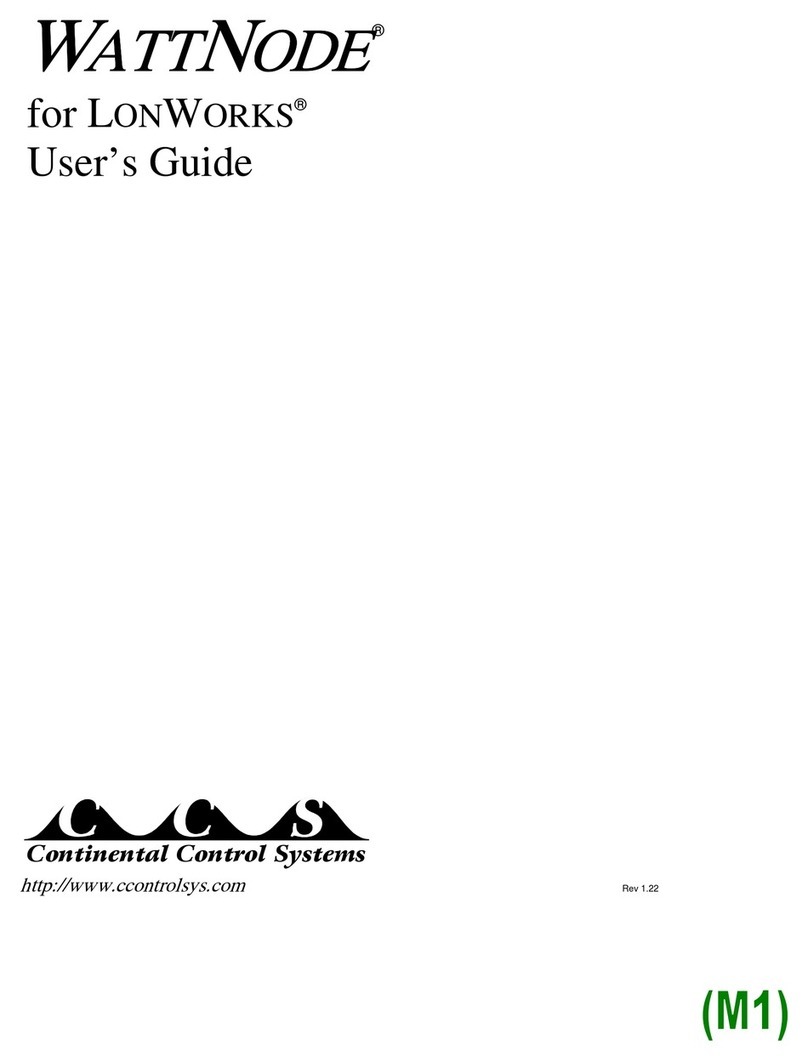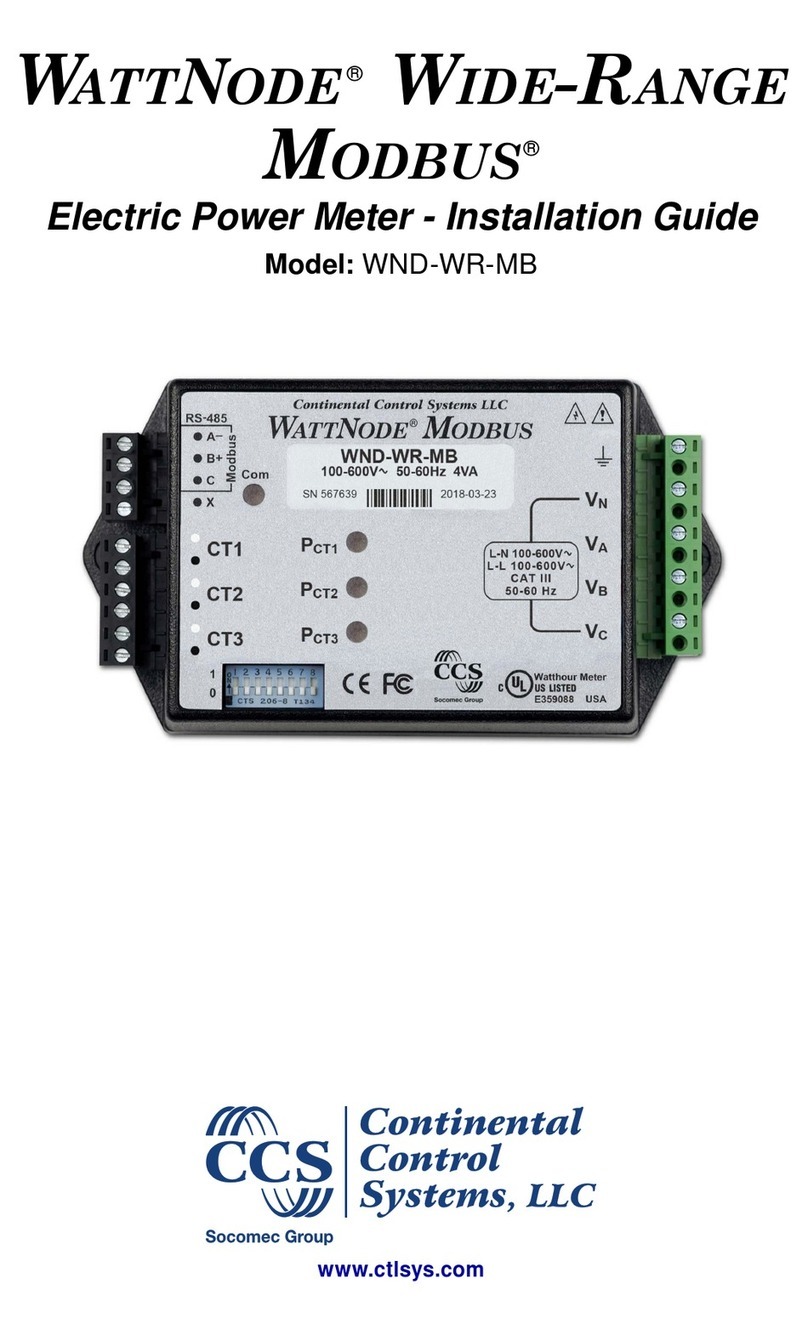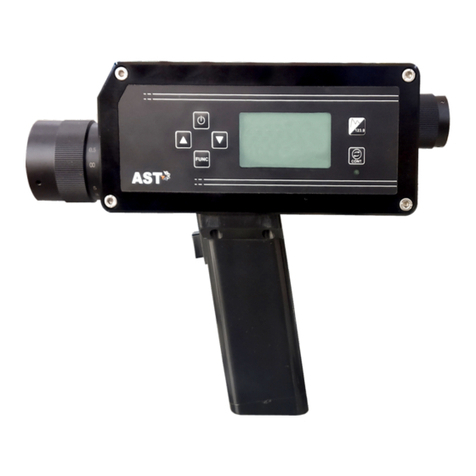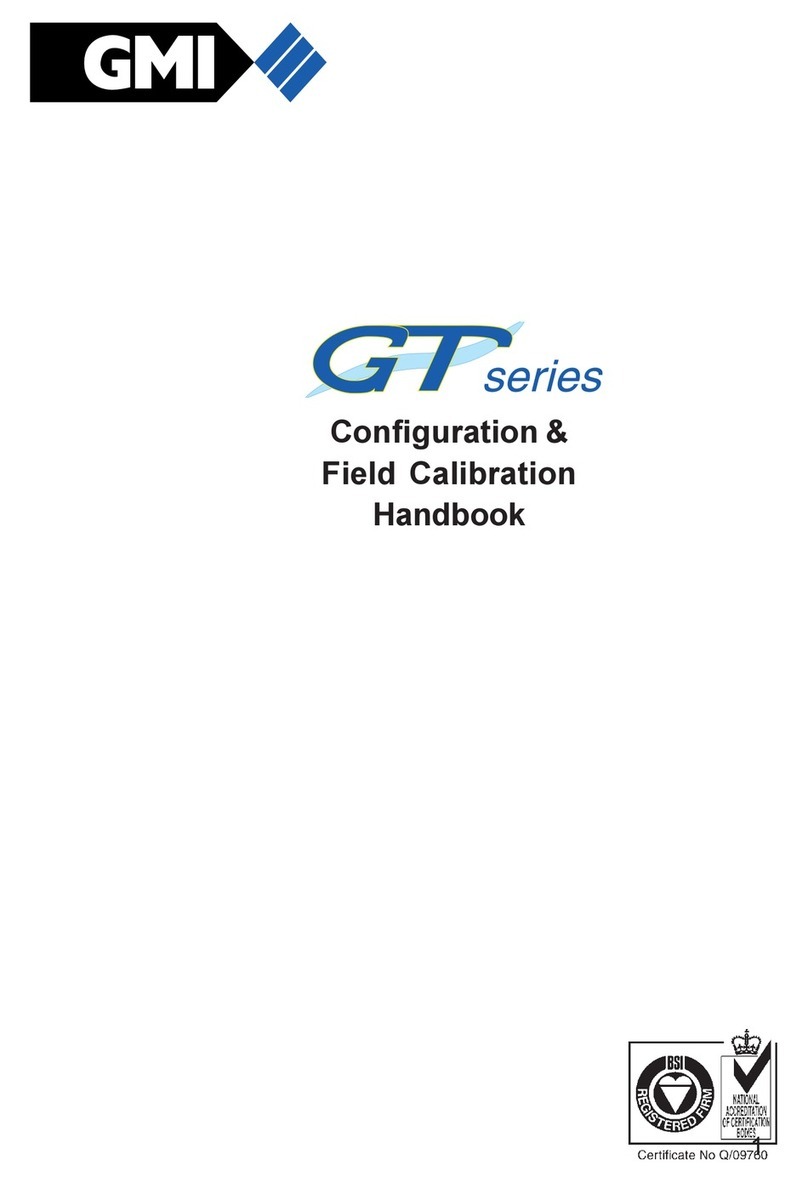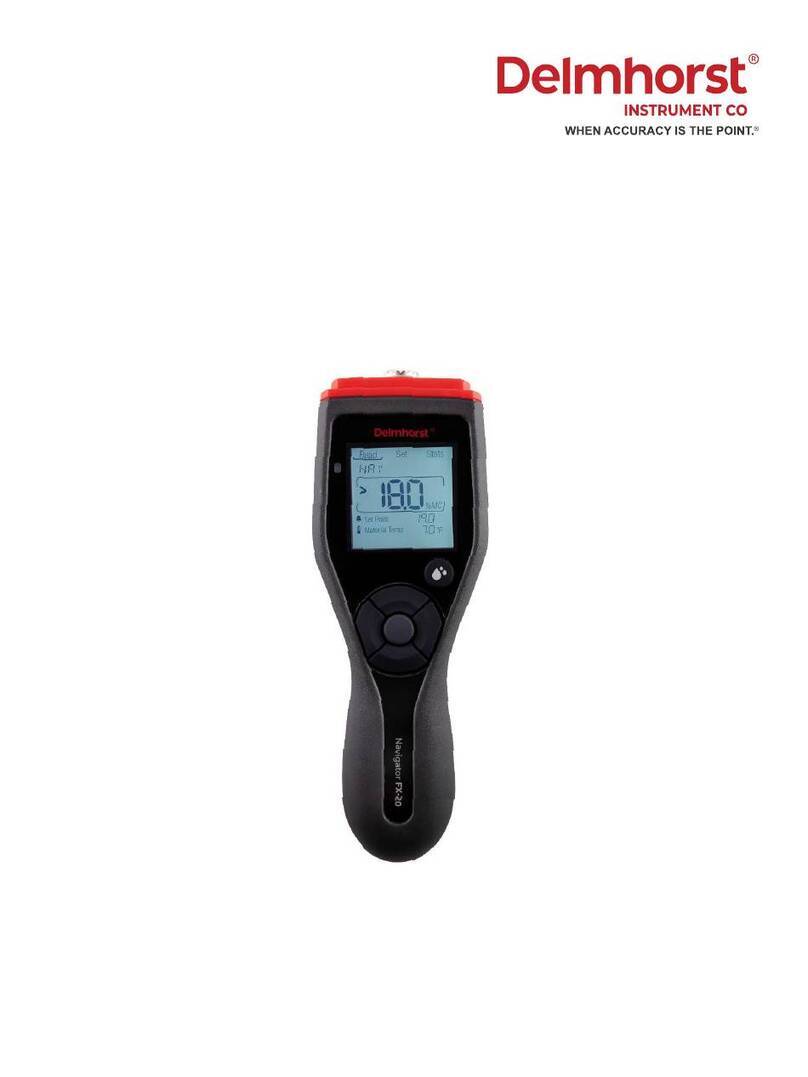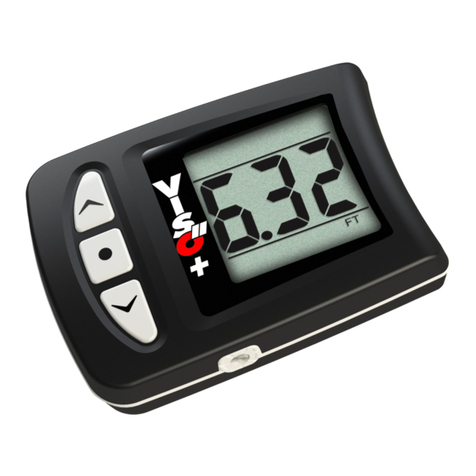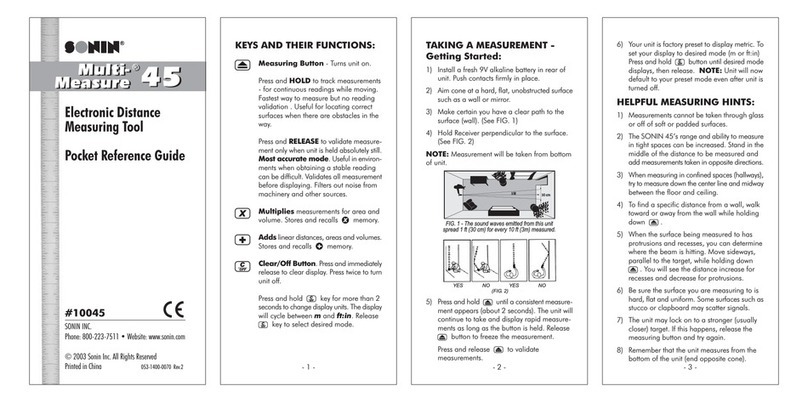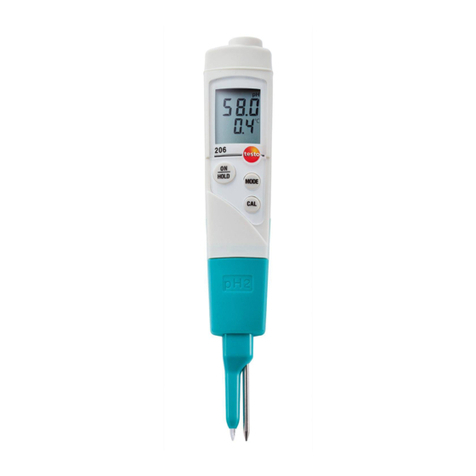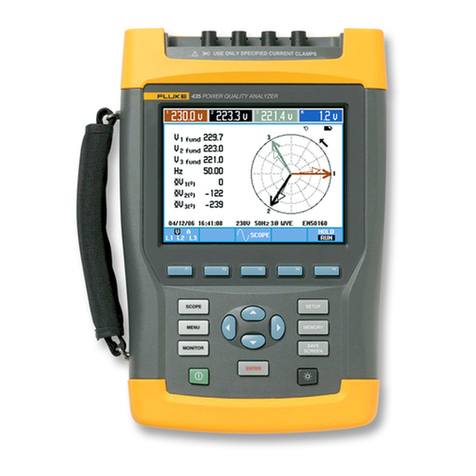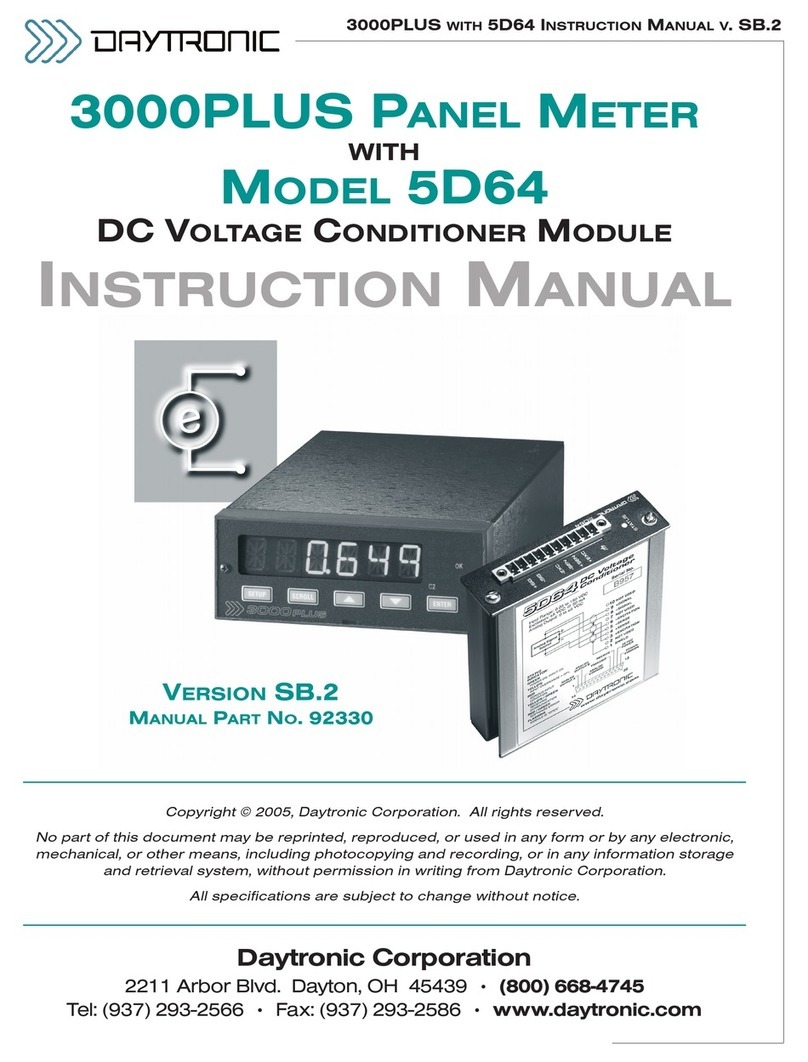CCS WattNode WNC-3Y-208-MB User manual

Rev 1.18c
(M7)
WattNode Modbus
Models
●WNC-3Y-208-MB
●WNC-3Y-400-MB
●WNC-3Y-480-MB
●WNC-3Y-600-MB
●WNC-3D-240-MB
●WNC-3D-400-MB
●WNC-3D-480-MB
WattNode Revenue for
Modbus Models
●RWNC-3Y-208-MB
●RWNC-3Y-400-MB
●RWNC-3Y-480-MB
●RWNC-3Y-600-MB
●RWNC-3D-240-MB
●RWNC-3D-400-MB
●RWNC-3D-480-MB
WattNode®Modbus
Installation and Operation Manual
Test Equipment Depot - 800.517.8431 - 5 Commonwealth Ave, Woburn MA 01801 - TestEquipmentDepot.com

2
This equipment has been tested and complies with the limits for a Class B digital device, pursu-
ant to part 15 of the FCC Rules. Operation is subject to the following two conditions: (1) This
device may not cause harmful interference, and (2) this device must accept any interference
received, including interference that may cause undesired operation.
The FCC limits are designed to provide reasonable protection against harmful interference in a
residential installation. This equipment generates, uses and can radiate radio frequency energy
and, if not installed and used in accordance with the instructions, may cause harmful interfer-
ence to radio communications. However, there is no guarantee that interference will not occur in
a particular installation. If this equipment does cause harmful interference to radio or television
reception, which can be determined by turning the equipment off and on, the user is encouraged
to try to correct the interference by one or more of the following measures:
●Reorient or relocate the receiving antenna.
●Increase the separation between the equipment and receiver.
●Connect the equipment into an outlet on a circuit different from that to which the receiver is
connected.
●Consult the dealer or an experienced radio/TV technician to help.

Contents 3
Contents
Overview ................................................................................................................................5
Measurements ................................................................................................................................ 5
Communication ............................................................................................................................... 5
Diagnostic LEDs .............................................................................................................................. 5
Options ........................................................................................................................................... 5
Current Transformers....................................................................................................................... 6
Additional Literature......................................................................................................................... 6
Front Label ...................................................................................................................................... 7
Installation .............................................................................................................................9
Precautions ..................................................................................................................................... 9
Electrical Service Types ..................................................................................................................10
Single-Phase Two-Wire with Neutral .........................................................................................10
Single-Phase Three-Wire (Mid-Point Neutral) ............................................................................11
Single-Phase Two-Wire without Neutral....................................................................................12
Three-Phase Four-Wire Wye.....................................................................................................13
Three-Phase Three-Wire Delta Without Neutral.........................................................................14
Three-Phase Four-Wire Delta (Wild Leg) ...................................................................................14
Grounded Leg Service .............................................................................................................14
Mounting........................................................................................................................................15
Selecting Current Transformers ......................................................................................................16
Connecting Current Transformers ...................................................................................................17
Circuit Protection............................................................................................................................18
Connecting Voltage Terminals.........................................................................................................19
Setting the Modbus Address ..........................................................................................................19
Baud Rate............................................................................................................................... 20
Connecting Modbus Outputs......................................................................................................... 20
Planning the Modbus Network ................................................................................................ 20
Installation Summary ..................................................................................................................... 22
Wiring ..................................................................................................................................... 22
Installation LED Diagnostics........................................................................................................... 23
Other Fixed Pattern ................................................................................................................. 25
Measurement Troubleshooting....................................................................................................... 25
Modbus Communication Diagnostics ............................................................................................ 28
Operating Instructions.........................................................................................................30
Quick Start.................................................................................................................................... 30
WattNode Basic Configuration ................................................................................................ 30
Verify Operation ...................................................................................................................... 30
Measurement Overview............................................................................................................31
Modbus Communication ................................................................................................................31
Modbus Functions ...................................................................................................................31
Modbus Register Lists................................................................................................................... 32
Modbus Register Addressing .................................................................................................. 32
Report Slave ID ....................................................................................................................... 32
Floating Point and Integer Registers ........................................................................................ 33
Reading and Writing 32 Bit Registers ...................................................................................... 33
Basic Register List - Floating Point .......................................................................................... 34
Basic Register List - Integer..................................................................................................... 34
Advanced Register List - Floating Point ................................................................................... 35

4 Contents
Advanced Register List - Integer.............................................................................................. 36
Configuration Register List .......................................................................................................37
Communication Register List................................................................................................... 38
Diagnostic Register List........................................................................................................... 38
Option Information Registers ................................................................................................... 39
Custom Register Map ............................................................................................................. 39
Basic Registers ............................................................................................................................. 40
Energy Registers ..................................................................................................................... 40
Power Registers...................................................................................................................... 40
Voltage Registers .....................................................................................................................41
Frequency ................................................................................................................................41
Advanced Registers .......................................................................................................................41
Per-Phase Energy Registers .....................................................................................................41
Positive Energy.........................................................................................................................41
Negative Energy...................................................................................................................... 42
Reactive Energy ...................................................................................................................... 42
Apparent Energy ..................................................................................................................... 42
Power Factor........................................................................................................................... 42
Reactive Power ....................................................................................................................... 43
Apparent Power ...................................................................................................................... 43
Current.................................................................................................................................... 44
Demand.................................................................................................................................. 44
I/O Pin Options........................................................................................................................ 46
Configuration Registers ................................................................................................................. 46
Demand Configuration ............................................................................................................ 48
Zeroing Registers .................................................................................................................... 49
I/O Pin Options Configuration .................................................................................................. 50
Communication Registers.............................................................................................................. 50
Diagnostic Registers.......................................................................................................................51
Error Codes................................................................................................................................... 52
Maintenance and Repair................................................................................................................ 54
Specifications ......................................................................................................................55
Models .......................................................................................................................................... 55
Model Options ........................................................................................................................ 55
Accuracy................................................................................................................................. 56
Measurement ................................................................................................................................ 57
Modbus Communication ............................................................................................................... 57
Electrical ....................................................................................................................................... 58
Certifications ................................................................................................................................. 59
Environmental................................................................................................................................ 59
Mechanical.................................................................................................................................... 59
Current Transformers..................................................................................................................... 59
Warranty...............................................................................................................................60
Limitation of Liability ...................................................................................................................... 60

Overview 5
Overview
Congratulations on your purchase of the WattNode®Modbus®watt/watt-hour transducer (meter).
The WattNode meter offers precision energy and power measurements in a compact pack-
age. It enables you to make power and energy measurements within existing electric service
panels avoiding the costly installation of subpanels and associated wiring. It is designed for use
in demand side management (DSM), sub-metering, and energy monitoring applications. The
WattNode meter communicates on an EIA RS-485 two-wire bus using the Modbus protocol.
Models are available for single-phase, three-phase wye, and three-phase delta configurations for
voltages from 120 VAC to 600 VAC at 50 and 60Hz.
Measurements
The WattNode Modbus meter measures the following:
●True RMS Power - Watts (Phase A, Phase B, Phase C, Sum)
●Reactive Power - VARs (Phase A, Phase B, Phase C, Sum)
●Power Factor (Phase A, Phase B, Phase C, Average)
●True RMS Energy - Watthours (Phase A, Phase B, Phase C, Sum)
●Reactive Energy - VAR-hours (Sum)
●AC Frequency
●RMS Voltage (Phase A, Phase B, Phase C)
●RMS Current (Phase A, Phase B, Phase C)
●Demand and Peak Demand
One WattNode Modbus meter can measure up to three different “single-phase two-wire with
neutral” branch circuits from the same service by separately monitoring the phase A, B, and C
values. If necessary, you can use different CTs on the different circuits.
Communication
The WattNode meter uses a half-duplex EIA RS-485 interface for communication. The standard
baud rates are 9,600 and 19,200 baud, and rates from 1,200 to 38,400 baud can be configured.
The meter uses the industry standard Modbus RTU (binary) communication protocol, allowing
up to 127 devices per RS-485 subnet. The WattNode meter can auto-detect RS-485 polarity on
properly biased networks, simplifying installation.
There are numerous low-cost RS-485 interfaces to PCs, using both USB and serial ports. There
are many PC programs and standalone devices for collecting and recording Modbus data.
Diagnostic LEDs
The meter includes three power diagnostic LEDs—one per phase. During normal operation,
these LEDs flash on and off, with the speed of flashing roughly proportional to the power on each
phase. The LEDs flash green for positive power and red for negative power. Other conditions are
signaled with different LED patterns. See Installation LED Diagnostics (p. 23)for details.
The Modbus WattNode meter includes a communication LED that lights green, yellow, or red to
diagnose the RS-485 network. See Modbus Communication Diagnostics (p. 28)for details.
Options
The WattNode Modbus meter can be ordered with several options. For more details and docu-
mentation, see article WattNode Modbus - Options on our website.
General Options
●Option CT=xxx - Pre-assign xxx as the global CtAmps value.

6 Overview
●Option CT=xxx/yyy/zzz - Pre-assign xxx to CtAmpsA, yyy to CtAmpsB, and zzz to
CtAmpsC.
Communication Options
●Option EP - Factory configure the Modbus RS-485 communications to even parity (E81).
●Option 19K - Factory configure the RS-485 communications 19,200 baud. Position 8 of the
DIP switch will be ignored.
●Option 38K - Factory configure the RS-485 communications to 38,400 baud. Position 8 of
the DIP switch will be ignored.
●Option TCP‑RTU - Configure the communications to the Modbus TCP-RTU protocol option
for use with RS-485 to Ethernet gateways (serial device adapters).
●Option AD - Factory configure the Modbus address. The DIP switch address will be ignored.
X Terminal Options
These options utilize the X(auxiliary) terminal on the MODBUS connector. Only one of these can
be ordered on any single meter.
●Option X5 - Provides 5 VDC at up to 60 milliamps between the C(common) and X(5 V)
terminals.
●Option IO - Provides a digital input (level sensing and pulse counting) or output (for load
shedding and other applications) on the Xterminal.
●Option SSR - Provides a solid-state relay (contact closure) output between the Xand C
terminals for load shedding and other applications.
Special Options
Contact the factory about the following special options:
●Option 232 - Provide RS-232 I/O in place of RS-485.
●Option TTL - Provide 5 V TTL UART I/O in place of RS-485.
Current Transformers
The WattNode meter uses solid-core (toroidal), split-core (opening), and bus-bar style current
transformers (CTs) with a full-scale voltage output of 0.33333 Vac. Split-core and bus-bar CTs
are easier to install without disconnecting the circuit being measured. Solid-core CTs are more
compact, generally more accurate, and less expensive, but installation requires that you discon-
nect the circuit to install the CTs.
Additional Literature
These additional documents are available on the Continental Control Systems, LLC website or
Modbus.org website.
●WattNode Modbus - Quick Install Guide
●WattNode Modbus Register List (Excel format): WNC-Modbus-Register-List-V18.xls
●Continental Control Systems, LLC website
○http://www.ccontrolsys.com/w/WattNode_Modbus - main page.
○http://www.ccontrolsys.com/w/Category:WattNode_Modbus - support articles.
●http://www.modbus.org/specs.php
○Modbus Application Protocol Specification - V1.1b
○Modbus over Serial Line - Specification & Implementation Guide - V1.0




10 Installation
Electrical Service Types
Below is a list of service types, with connections and recommended models. Note: the ground
connection improves measurement accuracy, but is not required for safety.
Electrical
Service (or Load) Types
Line-to-
Neutral (Vac)
Line-to-
Line
(Vac)
Meter
Service
Type
Meter
Powered by
1 Phase 2 Wire 120V with neutral 96 – 138 n.a. 3Y-208 Nand ØA
1 Phase 2 Wire 230V with neutral
(non-U.S.)
184 – 264 n.a. 3Y-400 Nand ØA
1 Phase 2 Wire 277V with neutral 222 – 318 n.a. 3Y-480 Nand ØA
1 Phase 2 Wire 208V no neutral n.a. 166 – 276 3D-240 ØAand ØB
1 Phase 2 Wire 240V no neutral n.a. 166 – 276 3D-240 ØAand ØB
1 Phase 3 Wire 120V/240V with
neutral 96 – 138 166 – 276 3Y-208 Nand ØA
3D-240 ØAand ØB
3 Phase 3 Wire Delta 208V no neutral n.a. 166 – 276 3D-240 ØAand ØB
3 Phase 3 Wire Delta 400V no neutral
(non-U.S.) n.a. 320 – 460 3D-400 ØAand ØB
3 Phase 3 Wire Delta 480V no neutral n.a. 384 – 552 3D-480 ØAand ØB
3 Phase 4 Wire Wye 120V/208V with
neutral 96 – 138 166 – 276 3Y-208 Nand ØA
3D-240 ØAand ØB
3 Phase 4 Wire Delta 120/208/240V
with neutral 96 – 138 166 – 276 3D-240 ØAand ØB
3 Phase 4 Wire Wye 230V/400V with
neutral (non-U.S.) 184 – 264 320 – 460 3Y-400 Nand ØA
3D-400ØAand ØB
3 Phase 4 Wire Wye 277V/480V with
neutral 222 – 318 384 – 552 3Y-480 Nand ØA
3D-480 ØAand ØB
3 Phase 4 Wire Delta 240/415/480V
with neutral 222 – 318 384 – 552 3D-480 ØAand ØB
3 Phase 4 Wire Wye 347V/600V with
neutral 278 – 399 480 – 690 3Y- 60 0 Nand ØA
Table 1: WattNode Models
Single-Phase Two-Wire with Neutral
This configuration is most often seen in homes and offices. The two conductors are neutral and
line. For these models, the meter is powered from the Nand ØAterminals.
Figure 2: Single-Phase Two-Wire Connection
Ground
WHITE
BLACK
ØB CT
ØC CT
ØA CT
ØB
ØC
N
ØA
Common
B+, D1, RxD+/TxD+
EIA-485
Monitoring Device
A−, D0, RxD−/TxD−
Continental Control Systems LLC
Status
Status
Status
X
C
B+
A
MODBUS
Com
WNC-
WATTNODE
®
MODBUS
-MB
Line
Neutral
LINE
LOAD
Shorting
Jumpers
Source
Face
Current
Transformer
3Y-xxx
Test Equipment Depot - 800.517.8431 - 5 Commonwealth Ave, Woburn MA 01801 - TestEquipmentDepot.com





Installation 15
The WattNode meter will correctly measure services with a grounded leg, but the measured volt-
age and power for the grounded phase will be zero and the status LED will not light for whichever
phase is grounded, because the voltage is near zero. Also, one or both of the active (non-
grounded) phases may indicate low power factor because this type of service results in unusual
power factors.
For optimum accuracy with a grounded leg, you should also connect the N(neutral) terminal
on the meter to the ground terminal; this will not cause any ground current to flow because the
neutral terminal is not used to power the meter. If you have a grounded leg configuration, you can
save money by removing the CT for the grounded phase, since all the power will be measured on
the non-grounded phases. We recommend putting the grounded leg on the ØBor ØCinputs and
attaching a note to the meter indicating this configuration for future reference.
Mounting
Protect the WattNode meter from moisture, direct sunlight, high temperatures, and conductive
pollution (salt spray, metal dust, etc.) If moisture or conductive pollution may be present, use an
IP 66 or NEMA 4 rated enclosure to protect the meter. Due to its exposed screw terminals, the
meter must be installed in an electrical service panel, an enclosure, or an electrical room. The
meter may be installed in any orientation, directly to a wall of an electrical panel or junction box.
153 mm (6.02 in)
38 mm (1.50 in) High
Ø
9.8 mm (0.386 in)
Ø
5.1 mm (0.200 in)
85.1 mm (3.35 in)
136.6 mm (5.375 in)
Figure 7: WattNode Meter Dimensions
The WattNode meter has two mounting holes spaced 5.375 inches (137 mm) apart (center to
center). These mounting holes are normally obscured by the detachable screw terminals. Remove
the screw terminals by pulling outward while rocking from end to end. The meter or Figure 7
may be used as a template to mark mounting hole positions, but do not drill the holes with the
meter in the mounting position because the drill may damage the connectors and leave drill
shavings in the connectors.
You may mount the meter with the supplied #8 self-tapping sheet metal screws using 1/8
inch pilot hole (3.2 mm). Or you may use hook-and-loop fasteners. If you use screws, avoid

16 Installation
Selecting Current Transformers
The rated full-scale current of the CTs should normally be chosen somewhat above the maximum
current of the circuit being measured (see Current Crest Factor below for more details). In some
cases, you might select CTs with a lower rated current to optimize accuracy at lower current
readings. Take care that the maximum allowable current for the CT can not be exceeded without
tripping a circuit breaker or fuse; see Current Transformers (p. 59).
We only offer CTs that measure AC current, not DC current. Significant DC current can saturate
the CT magnetic core, reducing the AC accuracy. Most loads only have AC current, but some rare
loads draw DC current, which can cause measurement errors. See our website for more informa-
tion: http://www.ccontrolsys.com/w/DC_Current_and_Half-Wave_Rectified_Loads.
CTs can measure lower currents than they were designed for by passing the wire through the
CT more than once. For example, to measure currents up to 1 amp with a 5 amp CT, loop the
wire through the CT five times. The CT is now effectively a 1 amp CT instead of a 5 amp CT. The
effective current rating of the CT is the labeled rating divided by the number of times that the wire
passes through the CT.
If you are using the measurement phases of the WattNode (ØA, ØB, and ØC) to measure dif-
ferent circuits, you can use CTs with different rated current on the different phases. Instead of
setting one CtAmps value for all phases, you can use different values for each phase: CtAmpsA,
CtAmpsB, and CtAmpsC.
Current Crest Factor
The term “current crest factor” is used to describe the ratio of the peak current to the RMS cur-
rent (the RMS current is the value reported by multimeters and the WattNode meter). Resistive
loads like heaters and incandescent lights have nearly sinusoidal current waveforms with a crest
factor near 1.4. Power factor corrected loads such as electronic lighting ballasts and computer
power supplies typically have a crest factor of 1.4 to 1.5. Battery chargers, VFD motor controls,
and other nonlinear loads can have current crest factors ranging from 2.0 to 3.0, and even higher.
High current crest factors are usually not an issue when metering whole building loads, but can
be a concern when metering individual loads with high current crest factors. If the peak current is
too high, the meter’s CT inputs can clip, causing inaccurate readings.
This means that when measuring loads with high current crest factors, you may want to be
conservative in selecting the CT rated current. For example, if your load draws 10 amps RMS, but
has a crest factor of 3.0, then the peak current is 30 amps. If you use a 15 amp CT, the meter will
not be able to accurately measure the 30 amp peak current. Note: this is a limitation of the meter
measurement circuitry, not the CT.
The following graph shows the maximum RMS current for accurate measurements as a function
of the current waveform crest factor. The current is shown as a percentage of CT rated current.
For example, if you have a 10 amp load with a crest factor of 2.0, the maximum CT current is
approximately 85%. Eighty-five percent of 15 amps is 12.75, which is higher than 10 amps, so
over-tightening which can crack the case. If you don’t use the supplied screws, the following
sizes should work (bold are preferred); use washers if the screws could pull through the mounting
holes
Screw Style U.S.A. UTS Sizes Metric Sizes
Pan Head or Round Head #6, #8, #10 M3.5, M4, M5
Truss Head #6, #8 M3.5, M4
Hex Washer Head (integrated washer) #6, #8 M3.5, M4
Hex Head (add washer) #6, #8, #10 M3.5, M4, M5
Table 2: Mounting Screws


18 Installation
Circuit Protection
The WattNode meter is considered “permanently connected equipment”, because it does not
use a conventional power cord that can be easily unplugged. Permanently connected equip-
ment must have overcurrent protection and be installed with a means to disconnect the
equipment.
●A switch, disconnect, or circuit breaker may be used to disconnect the meter and must be
as close as practical to the meter. If a switch or disconnect is used, then there must also be a
fuse or circuit breaker of appropriate rating protecting the meter.
●WattNode meters only draw 10-30 milliamps; CCS recommends using circuit breakers or
fuses rated for between 0.5 amps and 20 amps and rated for the line voltages and the cur-
rent interrupting rating required.
●The circuit breakers or fuses must protect the ungrounded supply conductors (the terminals
labeled ØA, ØB, and ØC). If neutral is also protected (this is rare), then the overcurrent protec-
tion device must interrupt neutral and the supply conductors simultaneously.
●Any switches or disconnects should have at least a 1 amp rating and must be rated for the
line voltages.
●The circuit protection / disconnect system must meet IEC 60947-1 and IEC 60947-3, as well
as all national and local electrical codes.
●The line voltage connections should be made with wire rated for use in a service panel or
junction box with a voltage rating sufficient for the highest voltage present. CCS recommends
14 or 12 AWG (1.5 mm2or 2.5 mm2) stranded wire, rated for 300 or 600 volts. Solid wire may
be used, but must be routed carefully to avoid putting excessive stress on the screw terminal.
●The WattNode meter has an earth connection, which should be connected for maximum
accuracy. However, this earth connection is not used for safety (protective) earthing.
To connect CTs, pass the wire to be measured through the CT and connect the CT to the meter.
Always remove power before disconnecting any live wires. Put the line conductors through
the CTs as shown in the section Electrical Service Types (p. 10). You may measure gener-
ated power by treating the generator as the source.
For solid-core CTs, disconnect the line voltage conductor to install it through the CT opening.
Split-core and bus-bar CTs can be opened for installation around a wire. Different models have
different opening mechanisms, so you should familiarize yourself with the CT mechanism before
starting the installation. A nylon cable tie can be secured around the CT to prevent inadvertent
opening.
Some split-core CT models have flat mating surfaces. When installing this type of CT, make sure
that mating surfaces are clean. Any debris between the mating surfaces will increase the gap,
decreasing accuracy.
Connect the CT lead wires to the meter terminals labeled ØA CT, ØB CT, and ØC CT. Route the
twisted black and white wires from the CT to the meter. Strip 1/4 inch (6 mm) of insulation off the
ends of the CT leads and connect to the six position black screw terminal block. Connect each
CT lead with the white wire aligned with the white dot on the label, and the black wire aligned with
the black dot. Note the order in which the phases are connected, as the voltage phases must
match the current phases for accurate power measurement.
Record the CT rated current as part of the installation record for each meter. If the conductors
being measured are passed through the CTs more than once, then the recorded rated CT current
is divided by the number of times that the conductor passes through the CT.

Installation 19
Connecting Voltage Terminals
Always turn off or disconnect power before connecting the voltage inputs to the meter. Con-
nect each phase voltage to the appropriate input on the green terminal block; also connect
ground and neutral (if required).
The voltage inputs to the meter do not need to be powered from to the same branch circuit as
the load being monitored. In other words, if you have a three-phase panel with a 100 A three-pole
breaker powering a motor that you wish to monitor, you can power the meter (or several meters)
from a separate 20 A three-pole breaker installed in the same, or even adjacent panel, so long as
the load and voltage connections are supplied from the same electric service.
The green screw terminals handle wire up to 12 AWG (2.5 mm2). Strip the wires to expose 1/4” (6
mm) of bare copper. When wiring the meter, do not put more than one wire under a screw. If you
need to distribute power to other meters, use wire nuts or a power distribution block. The section
Electrical Service Types (p. 10)shows the proper connections for the different meter models
and electrical services. Verify that the voltage line phases match the CT phases.
If there is any doubt that the meter voltage rating is correct for the circuit being measured, unplug
the green terminal block (to protect the meter), turn on the power, and use a voltmeter to compare
the voltages (probe the terminal block screws) to the values in the white box on the meter front
label. After testing, plug in the terminal block, making sure that is pushed in all the way.
The WattNode meter is powered from the voltage inputs: ØA(phase A) to N(neutral) for wye
“-3Y” models, or ØA to ØBfor delta “-3D” models. If the meter is not receiving at least 80% of the
nominal line voltage, it may stop operating. Since the meter consumes a small amount of power
itself (typically 1-3 watts), you may wish to power the meter from a separate circuit or place the
current transformers downstream of the meter, so its power consumption is not measured
For best accuracy, always connect the N(neutral) terminal on the meter. If you are using a delta
meter and the circuit has no neutral, then jumper the earth ground to the N(neutral) terminal.
When power is first applied to the meter, check that the LEDs behave normally (see Installa-
tion LED Diagnostics (p. 23)below): if you see the LEDs flashing red-green-red-green, then
disconnect the power immediately! This indicates the line voltage is too high for this model.
1.0sec
GRGRGRGRGRGR
GRGRGRGRGRGR
GRGRGRGRGRGR
C
B
A
Figure 9: WattNode LED Overvoltage Warning
Setting the Modbus Address
Every device on a Modbus network must have a unique address and the correct baud rate. The
WattNode Modbus meter sets the address and baud rate with an eight position DIP switch.
The WattNode meter supports Modbus addresses from 1 to 127 using the DIP switch. Address
0 is used for broadcast messages and is not a valid address. As shipped from the factory, the
meter will be configured with an address of 0, which is invalid and will prevent any communication
and cause the “Com” LED to light solid red.
Red
Set the Modbus address by switching DIP switch positions 1-7, each of which adds a different
value to the address. The change will take effect immediately.

20 Installation
DIP Switch 1 234567
Up (1) Value 1 2 4 8 16 32 64
Address Examples
1Up Down Down Down Down Down Down
1+2+4 = 7 Up Up Up Down Down Down Down
4+16 = 20 Down Down Up Down Up Down Down
1+2+16+32+64 = 115 Up Up Down Down Up Up Up
Table 3: Modbus Address Selection
For example, if DIP switch positions 3 and 5 are in the 1 (up) position and the rest are 0 (down),
the resulting Modbus address is 4 + 16 = 20.
Once you are communicating with the meter, you can change the address using either the DIP
switches or the Address (1652) register.
Setting all DIP switch positions to zero for ten seconds resets all communication settings to the
factory configuration. If you ordered communication options like Option EP, they will be applied.
This can be useful if you cannot communicate and need to return the meter to a known state.
Option AD
The WattNode Modbus meter can be ordered from the factory with the Modbus address pre-
programmed to any value from 1 to 247 using Option AD=xxx where xxx is the desired address.
If you want to change the address of a meter with Option AD, there are two options:
1) Set the address with the DIP switch: Set the DIP switches to the desired address, then
write 0 to the Address (1652) register (to override the factory programmed address). Finally,
write 1234 to the ApplyComConfig (1651) register to apply the new address.
2) Set the address with the Address register: Set the DIP switches to any non-zero address
so the meter won’t reset the address to the factory programmed value. Next write the new
address to the Address (1652) register. Finally, write 1234 to the ApplyComConfig (1651)
register to apply the change.
Baud Rate
Select the baud rate by setting DIP switch position 8 as shown below. The change will take effect
immediately. The baud rate can be programmed by the factory with Option 19K (19,200 baud)
or Option 38K (38,400 baud), in which case, DIP switch 8 has no effect. You may also use the
BaudRate register to reprogram the baud rate from 1,200 to 38,400 baud.
Baud Rate DIP Switch Position 8
9,600 (default) 0 (down)
19,200 1 (up)
Table 4: Baud Rate Selection
Connecting Modbus Outputs
The Modbus WattNode meter communicates using a serial EIA RS-485 interface. The meter uses
half-duplex two-wire (plus common) communication, so the same pair of wires is used for send-
ing AND receiving. Up to 127 devices can be connected together on the same RS-485 bus (or up
to 247 devices if you assign Modbus addresses using the Address register).
Planning the Modbus Network
EIA RS-485 networks should always be wired in a bus (or daisy-chain) configuration. In other
words, the bus should start at the PC, Modbus master, or monitoring device and then run to each
meter in turn. Try to avoid branches, and avoid home-run wiring (where each meter has its own
This manual suits for next models
13
Table of contents
Other CCS Measuring Instrument manuals
Popular Measuring Instrument manuals by other brands

Loavto Electric
Loavto Electric DME D305T2 instruction manual
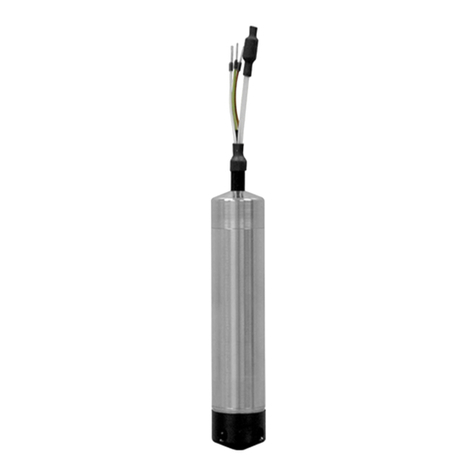
Winters
Winters LM7 Series Installation and operation manual

Shimpo
Shimpo DT-207L instruction manual
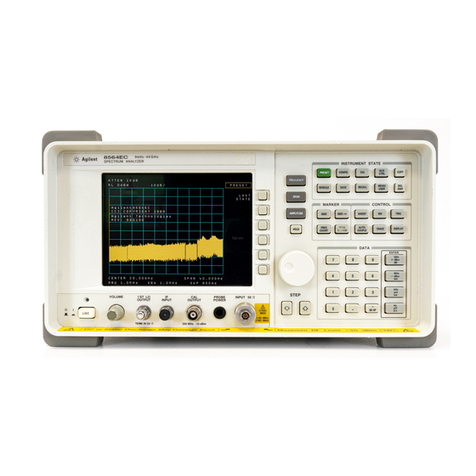
Agilent Technologies
Agilent Technologies 8564EC Service guide
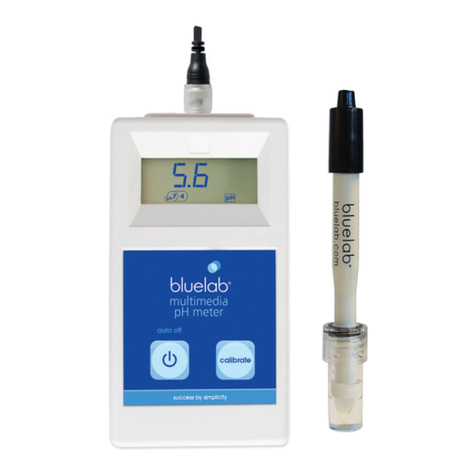
bluelab
bluelab Multimedia pHMeter Care and use guide
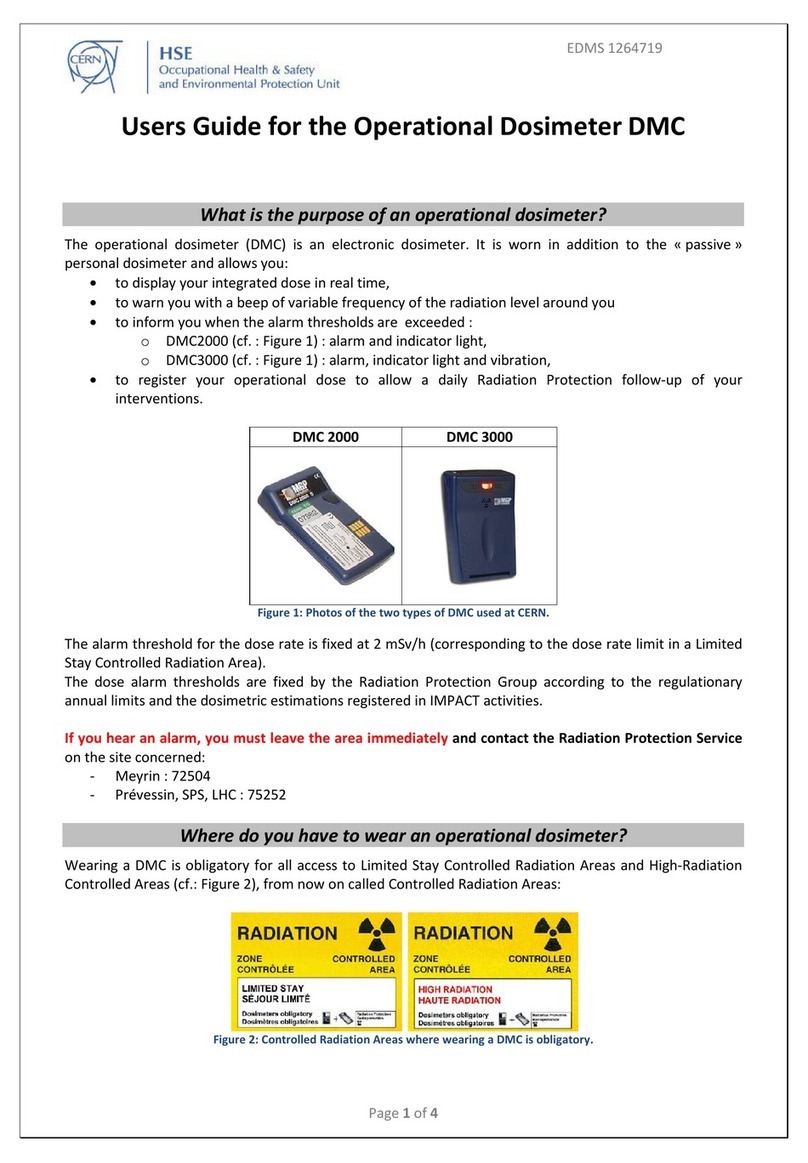
MGP Instruments
MGP Instruments DMC 2000 user guide
